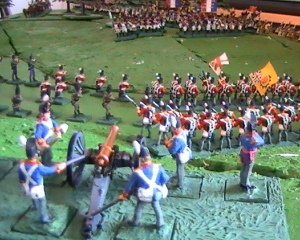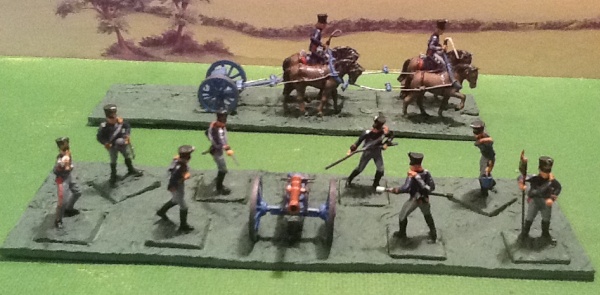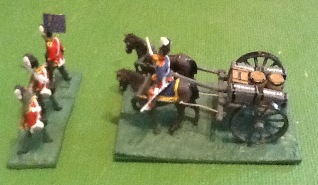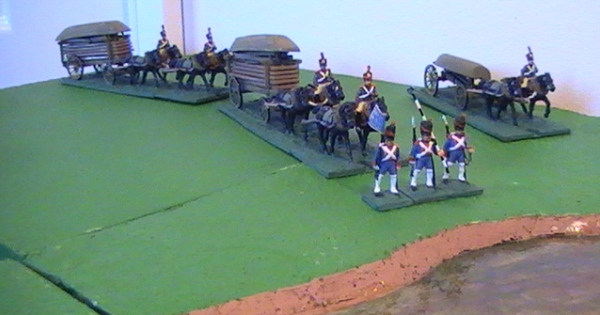I have always disliked the over-representation of artillery in many Napoleonic rules. It seems odd to me to represent infantry and cavalry at ratios of 20:1, 30:1 or 50:1, but represent artillery at 2:1 or 3:1 as many rules do.
I have had to compromise on this for my 18th Century artillery, since these were often deployed in pairs across the front of the army, so I did use a 1:2 ratio for that period, but I see no need to do the same for the Napoleonic era, when most artillery operated in batteries of 6 or 8 guns. The system I use for all my Napoleonic artillery is to have one gun model per battery, with the same number of crew as guns in the real battery, and even that gives twice as many artillerymen per battery as would be correct at the 1:30 ratio I use for infantry and cavalry. It is possible to make simple amendments to any rules to allow for this system.
I use deployed artillery bases which are proportionate to the frontage of the real battery. British guns wheels were 4 feet 2 inches apart, whilst French ones were 3 feet 11 inches, so 4 feet is a reasonable average. Major General Hughes, in his book “Open Fire” on artillery tactics says that the average space between guns in a battery was 20 yards (60 feet), whilst Rene Chartrand in his Osprey book French Napoleonic Field Artillery says it was 6 metres (20 feet). A compromise between these could be 12 yards (36 feet), so the frontage taken up by one gun and the space to the next one was 40 feet. On my 1mm = 2 feet ground scale this gives 20mm per real gun, so a six gun battery has a frontage of 120mm and an eight gun battery has a frontage of 160mm. Several rules which represent artillery on a ratio of 1:2 use 40mm per model gun, so my system gives exactly the same battery frontage. My deployed artillery bases are 50mm deep, which is enough to accommodate the gun and crew.
The artillerymen themselves are all on 15mm square bases. I make my deployment bases from a thin piece of card, with a thicker piece glued on top of it. The thicker piece has had 15mm squares cut out of it where I want my deployed artillerymen to be positioned. I find if I take a 15mm square base, and draw around it, then there is enough leeway to allow the artillerymen’s bases to fit into their allotted position. I then cover the raised surface of the deployment base with a thin layer of welded down sprue, using a miniature welding iron. Finally I make slight depressions in the thin sprue where the gun wheels and end of trail will sit, to help in positioning the gun.
I use one limber per gun and their bases are all 40mm wide. Foot artillery has a train of 4 horses up to 8/9 lb calibre, 6 horses for 12 lb and 8 horses for siege guns. Horse artillery has 4 horses up to 6 lb, but 6 horses for 9 lb. The two horses closest to the limber are on that same base, but the rest are in pairs on separate bases, all 40mm square. These clip together using a system like a jig-saw puzzle, so horse trains could be reduced by casualties. The main limber base is 110mm long, including the first pair of train horses, the limber itself and space for the limbered gun behind it. The base is covered in welded plastic sprue (as are all of my bases) and I score this to produce two ruts behind the limber wheels for the gun wheels to sit in when limbered. When deployed, I would normally place the limber behind the battery deployment base, turned sideways to represent a line of such limbers.
For horse artillery, I have alternate mounted and dismounted figures. The mounted figures are on 20mm wide by 30mm deep bases. Each represents a complete gun crew, so no additional figures as horse holders are represented. When deployed these are replaced by dismounted figures to crew the guns. There is also a horse line of dismounted horses, with one standing figure to represent the horseholders. I would place this behind the limber line whenever horse artillery is deployed.
I would assume that friendly troops could pass through a deployed battery, including its limber line and dismounted horse line, but that the battery could not fire when this was happening, and both the battery and the troops passing through would be disorganised. This is of course exactly what happened with D’Erlon’s Corps attack at Waterloo, passing through the Grand Battery. Some rules allow for this, and I would simply amend any which did not.
British Artillery

This is a deployed British RA (foot artillery) battery, on a hill as their troops advance beyond them. I would allow overhead firing from hills. The British RA figures are all converted from Airfix British Infantry, since at the time which I made them there were no plastic 1:72 British Foot Artillery being made. The gun is Airfix from their RHA set, but with a 9 lb barrel from the Esci British RHA set. I have three British RA Batteries.
This is a limbered British RHA Troop (battery) on the move. It is all Airfix, apart from the gun barrel which is Esci RHA. It is a 6lb battery, so has 4 train horses. I have always used the galloping Airfix British RHA horses for all horse artillery (regardless of nationality). I originally used walking Airfix French Artillery horses for foot artillery (of all nationalities) but more recently have used Hät artillery train horses. The crew is assumed to include the two men riding on the limber, so only 4 mounted figures are necessary to complete the 6 man crew. The mounted RHA figures are riding Airfix French Cuirassier horses. The rear two have been converted from Airfix RHA figures on foot.

You can see the “jig-saw” cut-out on the front of the lead pair of train horses, which would allow a futher pair of train horses to be attached, were it to be upgraded to a 9lb battery (as happened to some at Waterloo). I always model a marker pennant for my artillery, identifying the battery. When deployed it is on the left of the battery and I always place an officer on the right. I have standard positions for other crew members. I have two 6lb RHA Batteries, two 9lb RHA Batteries and a RHA Howitzer battery.
I also have two KGL HA 6lb batteries (one shown below) and a KGL 9lb Foot Battery. The KGL artillerymen wear identical uniforms to the British apart from their white over red plumes (RA and RHA had all white).

I also have an RHA Rocket Troop (battery). Here you can see my model Rocket Troop limbered, however I originally based this on a diagram in Congreve’s excellent booklet “The Rocket System” (my reprinted copy came from the RA Museum), which showed men sitting on the limber and rocket car. Since then I have since found that all men in the Rocket Troop were mounted, so have modified my model to reflect this.

This was built before there was any other model of it, however I would mention that the Hät model is not an accurate representation of a British rocket car, since they have modelled it as a simple cart. The British RHA rocket car was in fact based on the very flexible British Desaguliers limber system. For the limber itself, the base was a flat platform with two wheels (identical wheels to the 6 and 9 lb guns). On top of this a pair of ammunition boxes could be fitted side by side to form a limber, on which a pair of gunners could sit, as they did in RHA Troops, but not in the Rocket Troops.
 The rocket car was a variant of this. In this case two ammunition boxes were placed in the centre, one behind the other. Each side of them was a long narrow box, so that viewed from above the rocket car looked like an “H” shape. The central ammunition boxes contained rocket heads and the long boxes contained rocket sticks.
The rocket car was a variant of this. In this case two ammunition boxes were placed in the centre, one behind the other. Each side of them was a long narrow box, so that viewed from above the rocket car looked like an “H” shape. The central ammunition boxes contained rocket heads and the long boxes contained rocket sticks.

Rocket firing troughs were fitted on top of the two long boxes, which could be used attached to the rocket car or separately. The problem was that the rockets were very inaccurate, although when they were on target they were devastating and frightening to the enemy. My Rocket Troop gunners are converted from all Esci/Italeri RHA. I cannot remember why I painted the rockets red. I can only presume that I read it somewhere.

The Rocket system was very flexible. The larger rockets were carried on the rocket car, but every RHA Rocket artilleryman also carried four light rockets in saddlebags on his horse, and four sticks for them slung below his right arm, so that from a distance they looked like lancers. One RHA Troop Commander even gave his men unofficial lance pennons, as shown here.

The mounted rocket troopers could just ride out, dismount and fire their rockets from a small trough carried behind the saddle of one man in each detachment. They really operated in 3 man detachments, but I have only shown two here (plus a notional horseholder) to keep the total number of artillerymen in my Rocket Troop to six.
Some rules require batteries out of ammunition to withdraw to get fresh ammunition, but all Napoleonic armies used a forward resupply system of sending ammunition supply vehicles to the guns, which is why I like to have caissons or ammunition carts for my wargame figures.
British ammunition resupply carts were formed from identical Desaguliers limbers with four ammunition boxes on them, two in front and two behind. Such ammunition carts were towed behind a standard limber, so the limber and cart contained a total of six ammunition boxes. I plan to model these in the future.
Allied Artillery

I have one Hanoverian Foot Artillery battery, virtually identical to the British RA, apart from some uniform details, so the gunners are converted Airfix British Infantry. I have shown the officer with a yellow Hanoverian sash and all of the men are wearing Hanoverian white over yellow plumes, which is purely speculative.

I also have two Brunswick batteries, one foot and one horse artillery. The gunners are all converted from Airfix British RHA with Airfix French heads.
I have two Netherlands batteries, one foot and one horse. I also have a half battery of Netherlands Horse Artillery, shown below, which supported their Cavalry. All of these gunners are converted Airfix French Artillery.


I have three Portuguese foot batteries, one being a howitzer battery. The gunners are all converted from Airfix French Artillery, with Airfix British heads.
I also have a Loyal Lusitanian Legion 3lb mule battery. I wanted this so I could recreate the battle of the Alacantara Bridge, which is well described in the Osprey Raid “Oldest Allies” book.

The gunners are converted from Airfix French Artillery, with Airfix British heads, the civilian muleteer is converted from an Airfix Wagon Train figure, and the mules are from an Atlantic Alpenini set. The gun carriage is Airfix French Artillery, and its barrel is Hät. These can be detached from the first two mules to form the gun. The third mule is carrying ammunition boxes. Later Portuguese mule batteries had a fourth mule, and carried the trail and wheels separately.

Here is that same battery in action, the gun barrel and wheels being lifted off the mules and clipped together. I have put this small 3lb gun on a smaller than usual 120mm wide deployment base.

Lastly I have a Spanish Artillery battery. The gunners are converted from Airfix French Artillery. All of my artillery officers are looking through telescopes. The limber and train are Hät French, as are the drivers, converted with Airfix British RHA heads.
French Artillery
This is a French 8lb Foot Battery on the march. It is Airfix, but the gun itself is a British RHA carriage, with the trail cut off and an Airfix French trail welded on, plus an Esci gun barrel. The coffret box on the trail is scratch built. The limber is also scratch built, with wheels from the original Airfix French Artillery gun. I have three of these, plus one 12lb battery pulled by 6 horses. The 8 gunners (representing the 8 guns in the real battery) are Airfix French Artillery and the drivers converted from Airfix French Cuirassiers.

I also have three French 6lb Horse Artillery batteries. Here is one on the move. I have used Airfix British RHA horses to indicate that it is horse artillery. Unlike British RHA, all of the French Horse Artillerymen are mounted.


Here is the same battery deployed. Their deployment base is 120mm wide with six gunners on it. The gunners are all converted from Airfix British RHA with Airfix French heads.

My French Guard Foot Artillery has two batteries of Old Guard 6lb, three batteries of Old Guard 12lb and six batteries of 6lb Marine Artillery. The deployment base is 160mm wide with 8 gunners on it. All of the gunners are Airfix French Artillery, the Old Guard ones with their original shakos welded into bearskins.

I also have four batteries of French Guard Horse Artillery. The top halves of the gunners are Airfix British Hussars and their legs from Airfix Cuirassiers horseholders. The dismounted horses are from those horseholders. The alternate mounted figures (not shown) are Airfix British Hussars.
For ammunition resupply, for both artillery and infantry, I have 3 caissons for 2nd Corps one for 3rd Cavalry Corps and 5 for the Imperial Guard. These are all Hät.

Prussian Artillery
My Prussian Artillery currently comprises two 6lb batteries (one of these Landwehr), a 12lb battery and a 6lb Horse Artillery Battery. The gun and gunners are all Hät, apart from the Landwehr gunners, who are converted from Esci Russian Crimean Artillery, mainly by adding a peak to their caps and a blanket rolled over their left shoulder. The train horses are Airfix French, the drivers are Esci/Italeri Polish Lancers, with their heads swapped with Esci/Italeri French Infantry and the limber is scratch built, with wheels from the Airfix French Artillery gun.

Engineers

I have one company (3 figures) of British Royal Sappers and Miners. I have plans to have more, and add a company of Royal Staff Corps. They are all converted from Airfix British infantry figures. The two sappers on the right have their muskets slung over their right shoulders and are carrying a scratch built pick and shovel respectively. The Sergeant on the right is carrying a fanion.
They are accompanied by an engineer toolcart. This is copied from a large (9 inch long) model of one in the Royal Engineer Museum at Chatham.

The cart has toolboxes on it labelled: Carpenter, Bricklayer, Mason, Blacksmith etc, very similar to ones which we had when I was a Royal Engineer officer. The toolcart is a modified Desaguliers limber. In the centre of the cart are 2 barrels of gunpowder and a box of other engineer stores. The barrels and box are from the Italeri French Supply Wagon set.

I have one battalion (12 figures) of French Genie. These were converted from Airfix French marching gunners. They now have their muskets slung over their right shoulders and have picks, shovels or axes over their left shoulders. The officer is carrying a map or plan, as do all my Engineer Officers.They have a Hät caisson (shortened) for their additional equipment.

I also have a company (4 figures) of French Genie of the Guard, converted from Airfix French marching artillery, with converted Airfix British RHA heads.

Not strictly engineers, but often used in such a role, I also have a company of French Marines of the Guard (converted from Airfix British Infantry, with Airfix French heads).
I have one company (3 figures) of French Line Pontonier, and one of French Guard Pontonier (also 3 figures). These are all converted from Airfix French marching artillery, the Guard by welding their shakos into bearskins. The NCO carries a fanion. identifying the unit, one man has a boathook and the other a coil of rope.


They have 2 Hät pontoons per train, and each train also has one boat. The latter is one of a set of six (of various colours), which I have had since I was a young child, and I have no idea what make they are.


The boat can be used to ferry troops across the river to form a bridgehead, prior to building a pontoon bridge. Here two French Genie are ferrying across two Grenadiers and two Voltigeurs, all converted Esci French Infantry.

Here is a completed bridge, with the pontooniers marching over it first to prove it is safe, an engineer custom which survives to modern times.
Logistic
I have plans to model logistic troops for British and other armies, but at present have only French.
I have 5 baggage wagons for my French 2nd Corps, 1 for my French 3rd Cavalry Corps and 5 for my French Imperial Guard. These are all Hät and each have a pair of extra train horses from Hät French artillery train sets (the Hät baggage wagons originally only come with two train horses per wagon).

I also have scratch built forage wagons, one for 2nd Corps, one for 3rd Cavalry Corps and two for the French Imperial Guard.. The sides of these were made from model railway fencing, front wheels are from Airfix French Artillery and rear wheels from Esci Crimean Russian Artillery. The forage is cut up bits of nylon rope, covered with a piece of plastic bag as a tarpaulin. The forage wagons are pulled by Hät artillery train horses.

For medical support (although I have not figured out how to use it in a game yet), I have a large (4 wheel) French ambulance (Hät) for 2nd French Corps. This is accompanied by 2 infirmiers (converted Airfix French marching artillery). Their lances were designed to act as stretcher poles (as per the illustration in the Funken book).

I also have two 2 wheel ambulances designed to support the fast moving cavalry, one for 3rd Cavalry Corps and one for the Imperial Guard. These both have infirmier sitting on them (Italeri French wagon personnel).


For medical support to the Imperial Guard I have a large (4 wheel) French ambulance. This has been converted into the superior Guard version. This is are accompanied by 2 infirmiers (Italeri French wagon personnel in the Guard Administration Company uniform), sitting on the ambulance.
Lastly, I have some French cantinieres, one per Infantry Division or Cavalry Corps, but I have absolutely no idea how to use them in a wargame, unless perhaps to raise morale!!! Here is a selection of them.

The lead figure is the cantiniere of the Imperial Guard Cavalry. She is converted from an Airfix Maid Marion figure, riding sidesaddle, from their Robin Hood set.
The second figure is the cantiniere of 2nd Corps Cavalry and Artillery. She is from the Airfix Wagon Train set and is in a scratch built 2 wheeled covered cart. Her horse is from the Airfix ACW Artillery set, the cart wheels are from an Airfix Napoleonic French gun and the cover is a piece cut off from an Airfix Waggon Train wagon many years ago, when I converted one for the Zulu War with a rolled back cover (you can see that on my Zulu War page). I keep a box of old bits left over from conversions and this wagon cover came in useful 40 years after the original conversion.
The third figure is the cantiniere of the Young Guard. She is from the Airfix Wagon Train set and her mule is from the Airfix Tarzan set, with the barrel and box from the Airfix Wagon Train set.
The fourth figure is one of the French Infantry Division cantinieres and is a converted Airfix Red Indian squaw.